Mathematics and Art

Current MAM Home Page || Previous MAWs/MAMs || Current Activities



Optimal Geometry as Art
John M. Sullivan, University of Illinois, Urbana
torus.math.uiuc.edu/jms/
What is Mathematics?
Mathematics can be defined as the study of abstract patterns. Numbers, of course, are one of the first examples of an abstraction: two plus three is five, whether we're adding apples, or oranges, or something abstract like ideas. But for mathematicians, patterns of even greater abstraction are found all around us.Symmetries form another familiar example of patterns. The human visual system is especially sensitive to vertical mirror symmetry, as found (approximately) in the faces and bodies of most animals. Geometric symmetries like this are only the tip of the mathematical iceberg. Mathematicians find symmetries everywhere, for instance in number systems, or in equations and their solutions. Different symmetries of an object can be combined: for instance reflecting in two mirrors at once generates multiple images, some mirror-reversed and others not. It turns out that the rules for combining symmetries (the group laws of abstract algebra) are the same no matter whether the symmetries are geometric or not. Furthermore, these rules turn out to be similar to the rules of ordinary arithmetic.
Mathematics and Art
Mathematics can be related to art in many ways. One can study art mathematically, looking for symmetries or other relations in the construction of a painting or sculpture. Conversely, mathematical algorithms can be used to help create art: fractal systems, for instance, can recreate realistic shapes of plants, mountains and clouds.Famously, perspective drawing has a mathematical basis, and is a good example of how different the human brain is from a digital computer. It is trivial for a computer to apply the rules of perspective to project a three-dimensional model world to a two-dimensional drawing, while human artists often have difficulty applying these rules. On the other hand, we effortlessly use our visual system to reconstruct a three-dimensional model of the world around us from the two-dimensional images presented on our retinas. We thereby solve a very difficult (even ill-posed) problem that the best computers still have trouble with. Clearly, it is of great evolutionary advantage to be able to build accurate three-dimensional mental models of what we see, and we devote significant brain-power to doing this. The opposite task, converting this three-dimensional model back into a two-dimensional drawing, is mathematically simple, but gives little survival advantage, and (not surprisingly) is a difficult task for us, requiring conscious effort.
Mathematics in the Natural Sciences
Perhaps the Pythagoreans were the first to suggest that "at its deepest level, reality is mathematical in nature." Although by today's standards their mathematical tools were limited, they found interesting numerical patterns in musical harmonies as well as in geometric figures.
The flourishing of science in Europe during the Renaissance was made possible by increasing knowledge of mathematics. Galileo echoed Pythagoras when he observed that the laws of nature are "written in the language of mathematics."
It is surprising how often branches of pure mathematics that seem to have no application to the real world turn out later to be very important in physics or other fields. Eugene Wigner described this as "the unreasonable effectiveness of mathematics in the natural sciences," in his famous 1960 essay.
Optimization Problems
Perhaps one reason for this effectiveness of mathematics is that many laws of physics can be expressed in terms of minimizing free energy or minimizing action. These optimization problems have mathematical solutions.
In general, surface energies become more important than bulk energies at small scales: A small bug can easily walk on water, because the force of surface tension outweighs gravity at that small scale.
Thus problems about real-world materials, especially those concerning structure at small scales, can often be cast in the form of optimizing some feature of shape. The system minimizes some energy depending on the shape of a surface (or sometimes a curve) describing the material's structure. Mathematically, we obtain an optimization problem for some geometric energy.
A classical example is the soap bubble which minimizes its area while enclosing a fixed volume; this leads to the study of the more general constant-mean-curvature surfaces found in bubble-clusters and foams. Biological cell membranes, on the other hand, are more complicated bilayer surfaces, and seem to minimize an elastic bending energy known as the Willmore energy.
My own mathematical research concerns geometric optimization problems like these. I have looked also at singularities in higher-dimensional soap films, configurations of points on a sphere, and ropelength of knots. Ropelength describes how to optimally tie a given type of knot in a piece of real rope, and it seems to be related to the physical behavior of knotted loops of bacterial DNA.
Optimal Geometry as Art
Two thousand years ago, Seneca wrote that "All art is but imitation of nature." Assuming this, if nature can be described mathematically, the same should be true of art. Of course, current-day mathematics is not sufficient to describe truly complex systems, like humans and their relationships, which are the subjects of much great art. And perhaps some of these areas will forever stay outside the realm of mathematical analysis.
Often abstract art, including music, is closer to mathematics. Those aspects of nature, like optimization problems, that are most easily described in mathematical terms often lead to an abstract beauty. Henry James wrote that "in art economy is always beauty."
Like most research mathematicians, I find abstract beauty in the elegant and economical structure of mathematical proofs, and I feel that this elegance is discovered, not invented, by humans. I am fortunate, however, that my own work in optimal geometry leads directly to visually appealing shapes, which can present a kind of beauty more accessible to the general public.
My print Foamy Partition: Weaire-Phelan gives an interior view of a soap froth. The particular geometric structure of this froth, discovered in Ireland by Weaire and Phelan, partitions space into equal-volume cells, in what is likely to be the optimal way. Two other prints derive from The Optiverse, a video showing an optimal way to turn a sphere inside-out mathematically; this was a joint project with George Francis, Stuart Levy, and Camille Goudeseune. Optiverse: Framework Interior shows a triangulated computer simulation of part of the everting sphere, while Optiverse: Minimax Sphere Eversion uses bubble-like transparency to show the whole eversion.
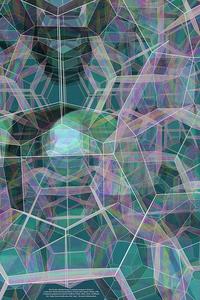
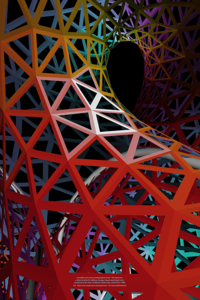
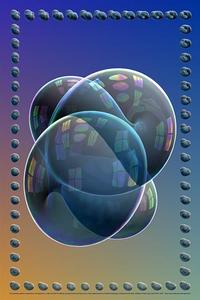 Figure: The first print, Foamy Partition: Weaire-Phelan, gives an interior view of the soap froth which is likely the optimal way to divide space into equal-volume cells. The other two prints come from the sphere eversion of The Optiverse. In the middle, Optiverse: Framework Interior shows a piece of the sphere when it is partly inside-out. At the right, Optiverse: Minimax Sphere Eversion renders the whole eversion as if it were made of soap film.
Figure: The first print, Foamy Partition: Weaire-Phelan, gives an interior view of the soap froth which is likely the optimal way to divide space into equal-volume cells. The other two prints come from the sphere eversion of The Optiverse. In the middle, Optiverse: Framework Interior shows a piece of the sphere when it is partly inside-out. At the right, Optiverse: Minimax Sphere Eversion renders the whole eversion as if it were made of soap film.Visualization challenges
In most scientific visualization, certain parameters are fixed by the physics. For instance, the colors in a photograph taken through a microscope are the real colors of a physical object, and should not be altered. In mathematical visualization, however, there are many choices, like colors, that can be made for purely aesthetic reasons. This is where a certain artistic judgment is needed.
However, rendering surfaces in a physically realistic way makes them easier to interpret, because our visual systems are used to looking at objects in the real world. For instance, instead of the flat transparency of typical computer graphics systems, my soap-film renderings use the true laws of thin-film optics, which I programmed into the shading language of Pixar's Renderman system. These thin films are less transparent when viewed from an angle, and this gives a much more realistic effect.
Mathematical objects in three dimensions, like foams or the self-intersecting surfaces found in a sphere eversion, tend to have complicated internal structure. This is hard to depict visually, because we are not used to looking at the insides of objects. Sometimes combining different depictions can better portray the structure. Some scenes in The Optiverse, for instance, were rendered transparently (as described above), while others used cutaway views (as in anatomical drawings) or solid surfaces (to emphasize the external shape).
Optimal geometry as sculpture
It is no surprise that sculpture is often the best medium for presenting three-dimensional shapes. The viewer can walk around the sculpture (or turn it) to get different views and effects. However, it is still difficult to depict internal structure: every part of the sculpture needs to be visible from some viewpoint. The most interesting sculptures, of course, hide different parts of their structure from different views, and surprise us with the changing views they present.
My sculpture Minimal Flower 3 is an homage to Brent Collins, whose sculptures have been very inspirational to me. For this sculpture, I designed the boundary curve and an initial surface by hand, and then used software to model a minimal surface. This, mathematically, is the optimal shape a soap-film spanning across the boundary would achieve. The geometric equilibrium of a minimal surface, where the curvatures of the surface always balance in a saddle configuration, adds to its beauty. The surface, like the boundary curve, has interesting symmetry: although the shape has a definite handedness, with no mirror symmetry, there is two-fold and three-fold rotational symmetry around different axes.
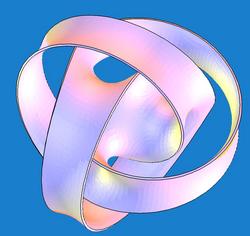
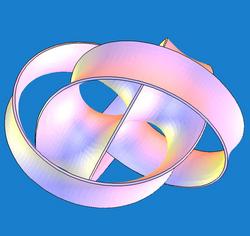 Figure: The sculpture Minimal Flower 3, shown here in two views, consists of a minimal surface spanning a knotted boundary curve. Topologically it is modeled on the Brent Collins sculpture Atomic Flower II, consisting of a central disk, with three orientation-reversing ribbons attached.
Figure: The sculpture Minimal Flower 3, shown here in two views, consists of a minimal surface spanning a knotted boundary curve. Topologically it is modeled on the Brent Collins sculpture Atomic Flower II, consisting of a central disk, with three orientation-reversing ribbons attached.
| Mathematics Awareness Month is sponsored each year by the Joint Policy Board for Mathematics to recognize the importance of mathematics through written materials and an accompanying poster that highlight mathematical developments and applications in a particular area. |